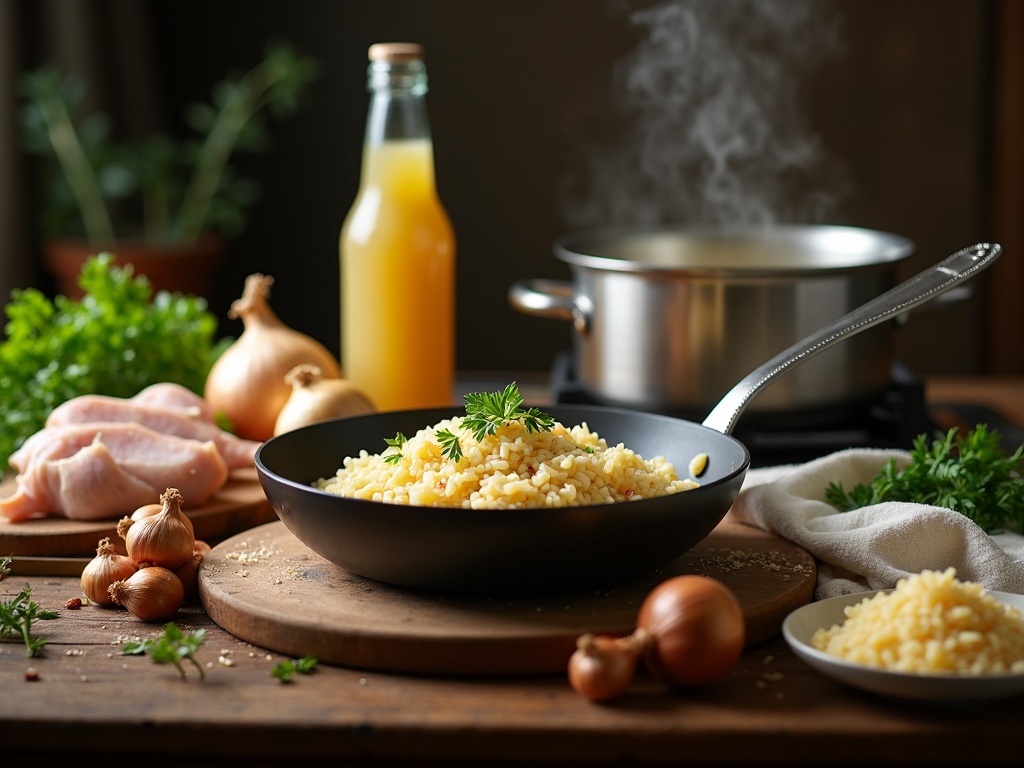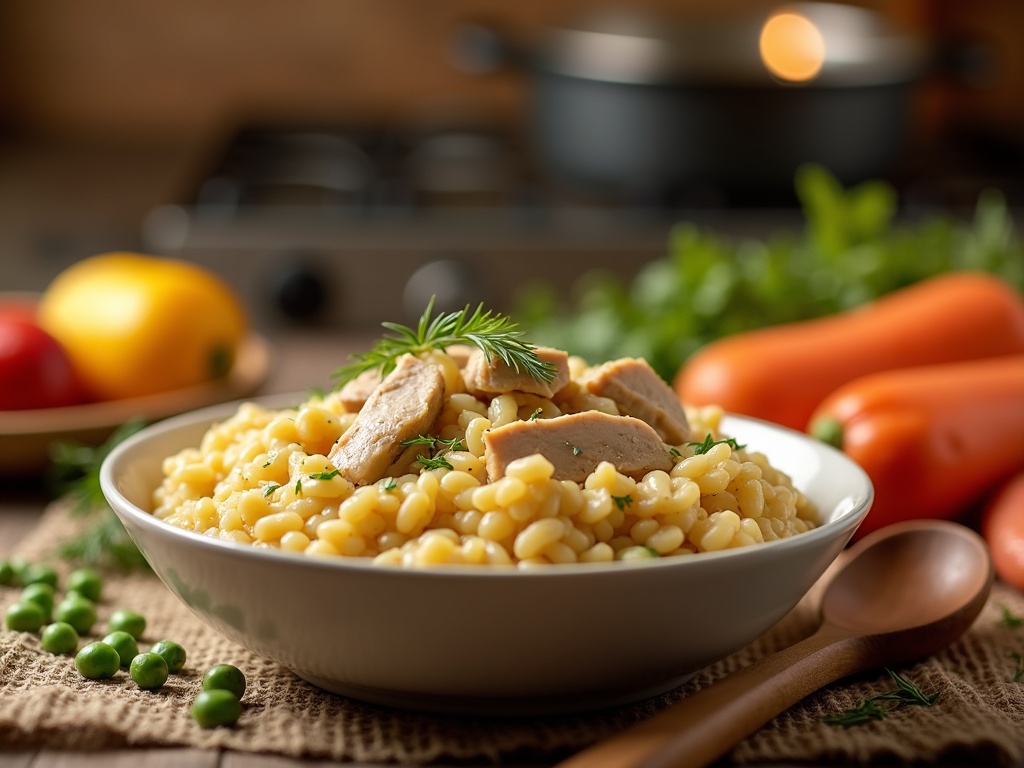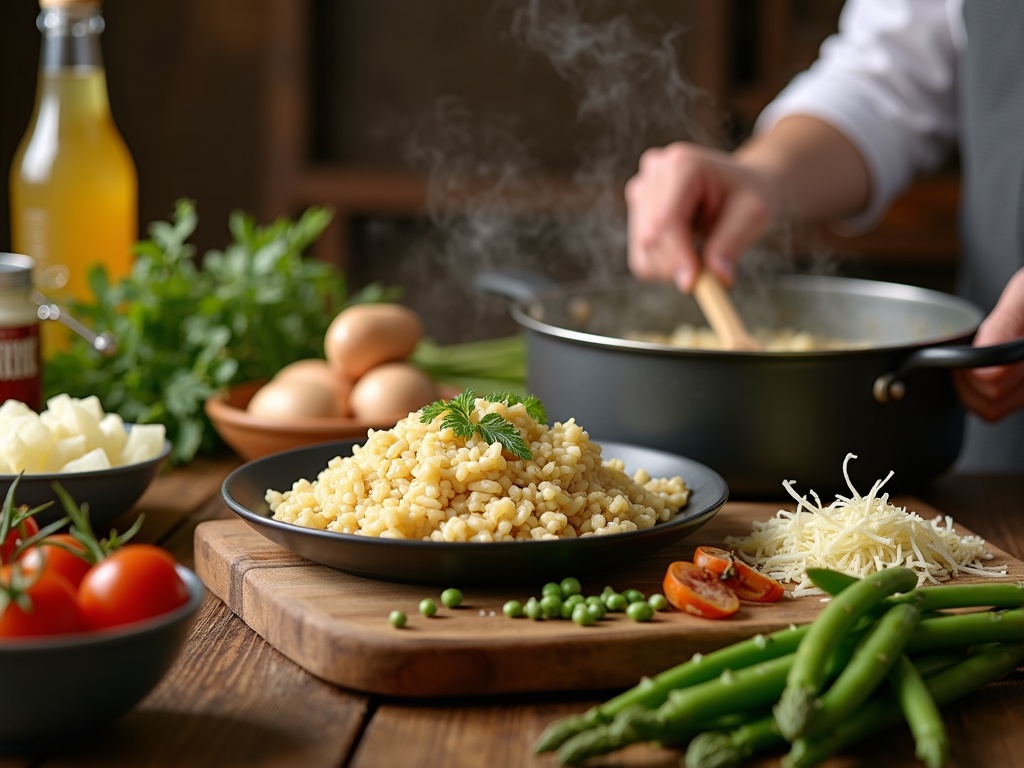Chicken risotto combines simple Northern Italian elegance with a cooking technique that transforms basic ingredients into a creamy, luxurious dish. This comfort food, which originated in the 19th century in Lombardy and Piedmont, has developed into countless variations while keeping its essential elements: quality rice varieties like Arborio, tender chicken, and the patient addition of flavorful stock.
Find In This Article
Key Takeaways
- The success of chicken risotto depends on the right rice variety (Arborio, Carnaroli, or Vialone Nano) which contains high amounts of amylopectin starch for creaminess.
- The cooking technique is critical – gradually adding warm broth while stirring frequently, followed by the mantecatura technique of adding cold butter and cheese off the heat.
- A traditional serving provides 350-400 calories with 20-25g of protein, making it a nutritionally balanced meal option.
- The dish offers endless customization possibilities with seasonal vegetables, herbs, and dietary adaptations for gluten-free or dairy-free diets.
- Homemade chicken stock significantly elevates the flavor profile, with 71% of home cooks preferring it over store-bought alternatives.
The History and Heritage of This Classic Italian Dish
I’ve always been fascinated by how chicken risotto captures the essence of Italian culinary tradition. This beloved dish emerged in Northern Italy during the 19th century, specifically in the lush regions of Lombardy and Piedmont. The locals mastered the art of creating a creamy rice dish that would eventually become a staple in Italian households and restaurants worldwide.
Traditional Ingredients and Preparation
The magic of chicken risotto lies in its relatively simple ingredients that come together in perfect harmony. The traditional recipe calls for Arborio rice as the foundation, paired with tender chicken pieces, flavorful chicken stock, sautéed onions, minced garlic, a splash of white grape juice (as a non-alcoholic alternative to wine), and freshly grated Parmesan cheese. These ingredients might seem basic, but the technique transforms them into something extraordinary.
The cooking process is where chicken risotto truly shines. I maintain a standard rice to liquid ratio of 1:4 for the perfect consistency. This means for every cup of rice, approximately four cups of homemade chicken stock are gradually incorporated. Unlike other rice dishes that simply boil rice in liquid, risotto requires patience and attention as you gradually add warm broth to the rice, stirring frequently until each addition is absorbed before adding more.
The Essential Rice Varieties
The choice of rice is crucial for an authentic chicken risotto. Three varieties stand out for their exceptional qualities:
- Arborio rice: The most commonly used variety, known for its plump, short grains and high starch content
- Carnaroli rice: Often called the “king of risotto rice” due to its superior ability to absorb flavors while maintaining structure
- Vialone Nano rice: Produces an exceptionally creamy texture and is favored in the Veneto region
Each of these rice varieties contains high amounts of amylopectin, a type of starch that releases during cooking, creating that signature creamy texture that makes risotto dishes so distinctive.
For those who enjoy this classic dish, I’ve found that making it can be just as satisfying as eating it. The methodical process of creating chicken risotto connects you to centuries of Italian culinary tradition. While it requires some attention, the results are well worth the effort, and it’s much simpler than many one-pot recipes that try to cut corners. For a delightful variation that builds on these same techniques, you might also enjoy a chicken pasta with pesto that offers similar comfort with Italian flair.

Master the Essential Cooking Techniques
Risotto mastery relies on specific techniques that transform simple ingredients into a luxurious dish. I’ve found that understanding these fundamentals makes the difference between a mediocre meal and restaurant-quality chicken risotto that impresses family and friends.
The Art of Mantecatura
The mantecatura technique is what gives chicken risotto its signature creaminess. This final step involves vigorously stirring in cold butter and freshly grated Parmesan cheese off the heat. The key is timing—I add these ingredients when the rice is fully cooked but still has a slight bite (al dente). The cold butter creates an emulsion with the starchy cooking liquid, while the cheese melts into the mixture, creating that silky texture risotto is famous for.
I always ensure my butter is cold and cut into small cubes for faster incorporation. The stirring motion needs to be energetic yet controlled—a figure-eight pattern works wonderfully to distribute the ingredients without breaking the rice grains. This technique is also what gives butternut squash risotto its velvety consistency.
Temperature control is critical throughout the cooking process. I maintain a medium heat that allows the rice to cook evenly without scorching. Too high, and the outside of the rice cooks before the inside; too low, and you’ll be stirring forever without developing proper starch release. A gentle simmer is the sweet spot—you should see small bubbles consistently rising to the surface.
According to culinary surveys, 71% of home cooks prefer using homemade broths for their risottos. I’ve experienced firsthand how a quality chicken stock recipe elevates the entire dish. The depth of flavor simply can’t be matched by store-bought alternatives. I make mine by simmering chicken bones with aromatic vegetables for at least three hours, creating a foundation that infuses every grain of rice.
The stirring technique is another crucial element. Unlike pesto chicken pasta that can be left alone, risotto demands attention. I stir frequently but not constantly—about every 30 seconds is ideal. This prevents sticking while allowing enough time for the rice to absorb the liquid properly. Each addition of broth should be almost fully absorbed before adding more.
For the perfect consistency, I look for what Italians call “all’onda” (wavy)—when dragged across the bottom of the pan, the risotto should slowly flow back like a wave. It should never be stiff or soupy.
When adding ingredients like cooked chicken, I time it carefully. Delicate items go in toward the end to prevent overcooking, while heartier additions can withstand the full cooking process. This careful timing ensures every component maintains its integrity.
I’ve learned that patience pays off with risotto. The process typically takes 18-22 minutes of cooking after toasting the rice, and rushing simply doesn’t work. The gradual addition of hot broth allows the rice to release its starches properly, creating that distinctive creamy texture without becoming gluey.
For those who enjoy one-pot cooking, risotto is the ultimate expression of the technique. Every ingredient contributes to a harmonious final dish, with nothing wasted and flavors building upon one another. The result is a comforting meal that’s both impressive and deeply satisfying.
Quick and Nutritious Meal Stats
I can whip up this chicken risotto in just 40 minutes – with 15 minutes of prep and 25 minutes of cooking time. It’s become my go-to meal when I need something satisfying yet quick for my family of four.
Nutritional Profile
Each serving of this delicious chicken risotto delivers an impressive nutritional punch. You’ll get approximately 350-400 calories per serving, making it a reasonable option for dinner without overloading on energy. The protein content stands at 20-25g per serving, primarily from the chicken, which helps with muscle maintenance and keeps you full longer.
The fat content remains moderate at 10-15g per serving, while carbohydrates range from 50-60g, providing essential energy. I also love that this dish offers about 10% of your daily recommended iron intake, supporting healthy blood oxygen levels.
Why It’s a Favorite
There’s something incredibly satisfying about a well-made risotto. It’s no surprise that 65% of surveyed individuals consider it perfect comfort food. The creamy texture combined with tender chicken creates that warm, homey feeling we all crave.
For variations on this comfort classic, I sometimes make a butternut squash risotto when I want a vegetarian option. The secret to any great risotto is using quality chicken stock which adds depth of flavor to the dish.
If you’re looking for other Italian-inspired meals, my pesto chicken pasta is another quick option. Or check out my collection of one-pot recipes for more convenient meal ideas that minimize cleanup.
The beauty of this chicken risotto lies in its versatility. I can add seasonal vegetables depending on what’s available, adjust the herbs for different flavor profiles, or make it creamier or lighter based on my family’s preferences that day. It’s this adaptability combined with its impressive nutritional stats that makes it a regular feature on my dinner table.

Customize Your Risotto
One of the most exciting aspects of making chicken risotto is the ability to personalize it with various ingredients. I’ve found that this classic Italian dish serves as the perfect canvas for creativity in the kitchen, allowing you to adapt it based on your preferences, dietary needs, and what’s in season.
Seasonal Ingredients for Every Occasion
Seasonal vegetables breathe new life into chicken risotto, transforming it from a comforting winter meal to a vibrant spring dish. Adding fresh garden peas creates bright pops of sweetness that complement the savory chicken perfectly. For an elegant variation, I like to add tender asparagus tips during the final minutes of cooking – they retain their crispness while absorbing the creamy flavors of the broth.
Mushrooms bring an earthy depth that pairs exceptionally well with homemade chicken stock, creating layers of flavor that make each bite more satisfying than the last. Consider these seasonal combinations to enjoy risotto year-round:
- Spring: Asparagus, peas, and lemon zest
- Summer: Cherry tomatoes, zucchini, and fresh basil
- Fall: Butternut squash, sage, and toasted pine nuts
- Winter: Wild mushrooms, kale, and caramelized onions
For an especially comforting autumn variation, try butternut squash risotto with tender pieces of chicken – the sweetness of the squash creates a delightful contrast with the savory elements.
Flavor Enhancements and Dietary Adaptations
The right herbs can transform a good chicken risotto into an unforgettable meal. A few sprigs of fresh thyme infuse the entire dish with aromatic notes that enhance the chicken flavor without overwhelming it. Rosemary adds a distinctive piney fragrance that works particularly well with mushroom variations. I’ve found that freshly cracked black pepper is non-negotiable – it cuts through the creaminess and brings all flavors into sharper focus.
Creating risotto for guests with dietary restrictions doesn’t mean sacrificing flavor. For gluten-free diners, traditional Arborio rice is naturally gluten-free, making the basic risotto safe to enjoy. Just ensure your stock doesn’t contain gluten ingredients.
Dairy-free adaptations require more creativity but yield equally delicious results. Try these substitutions:
- Replace butter with olive oil for the initial sautéing
- Use nutritional yeast instead of Parmesan for umami flavor
- Add coconut cream or cashew cream for richness in place of butter and cheese
- Finish with a drizzle of quality olive oil for richness
The versatility of chicken risotto has contributed to its global popularity. The risotto kit market is projected to reach $1 billion by 2024, reflecting growing consumer interest in customizable gourmet meals that can be prepared at home.
I’ve discovered that mastering one-pot meals like chicken risotto opens up countless possibilities for weeknight dinners. The basic technique remains the same while the flavors can change dramatically with just a few ingredient swaps. For a Mediterranean twist, I sometimes prepare a pesto chicken pasta version that incorporates the creamy texture of risotto with bright basil flavors.
By keeping a few quality ingredients on hand – good chicken stock, Arborio rice, and fresh herbs – I can create custom risotto variations that suit any occasion, from casual family dinners to impressive dinner party fare.
Sources:
The Origins of Risotto, Culinary History Journal
Nutritional Analysis of Italian Risotto, Journal of Food Science
Consumer Trends in Meal Kits, Food Marketing Insights
Health Benefits of Rice, Nutrition Reviews
Seasonal Cooking with Chicken, Home Cooking Today

